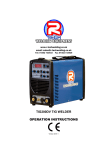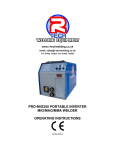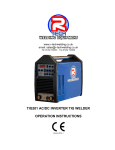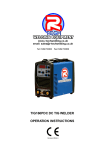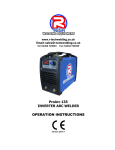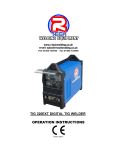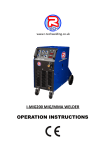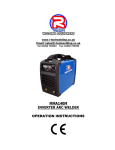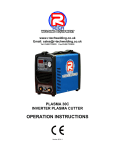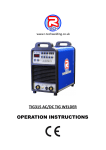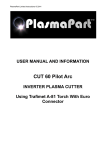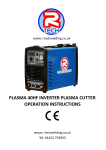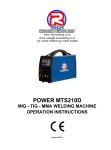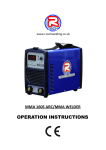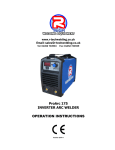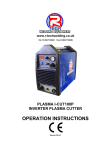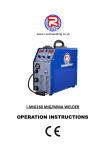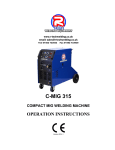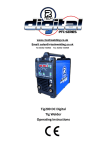Download TIG200PD Digital 2014 - R-Tech Welding Equipment Ltd
Transcript
www.r-techwelding.co.uk email: [email protected] Tel: 01452 733933 Fax 01452 733939 TIG200PD DIGITAL TIG WELDER OPERATION INSTRUCTIONS Version 2014-1 2 3 Thank you for selecting the R-Tech Tig200PD Digital Inverter DC Tig Welder. The Tig200PD Digital has many benefits over traditional tig welders, including pulse welding, slope up/down, remote foot option and an industrial 60% duty cycle. We want you to take pride in operating our Tig200PD Digital as much pride as we have taken in making this product for you. Please read all information in this manual before operation PLEASE EXAMINE CARTON AND EQUIPMENT FOR DAMAGE IMMEDIATELY When this equipment is shipped, title passes to the purchaser upon receipt from the courier. Consequently all claims for material damaged in shipment must be made by purchaser against the transportation company used. Please record your equipment identification below for future reference. This information can be found on data plate at rear of machine. Product TIG200PD DIGITAL Serial No. ___________________________________ Date of Purchase _____________________________ Where Purchased _____________________________ Whenever you request replacement parts or information on this equipment please always supply information you have recorded above This product is covered by 2 years parts and labour warranty, R-Tech will cover costs of collection, repair and return of welder to you for mainland UK (Other areas are RTB warranty). External items, torch, earth lead etc are covered by 3 months warranty. Any faults/damage found caused by customer will be charged pro-rata. Pay particular attention to the safety instructions we have provided you for your protection The level of seriousness to be applied to each section is explained below WARNING This statement appears where the information must be followed exactly to avoid serious personal injury. CAUTION This statement appears where the information must be following to avoid a minor personal injury or damage to this equipment. 4 Introduction The R-Tech Tig200PD Digital is a member of our field acclaimed family of welding products. Premium features include:1. 2. 3. 4. 5. 6. 7. Inverter power source – more efficient to operate, provides smoother weld characteristics. Full Featured Pulse welding in DC Tig welding mode HF Arc start – Easy arc striking and prolonged tungsten life Slope up / slope down Remote foot pedal option Digital control panel with memory store function. Industrial 60% Duty cycle at 200 Amps @ 40C Recommended Processes The R-Tech Tig200PD Digital is recommended for the Tig welding processes within its output capacity of 200 Amps Equipment Limitations The R-Tech Tig200PD Digital is protected from overloads beyond the output ratings and duty cycle as per machine specifications with thermostat protection of the output coils and rectifiers. Welding Capability – Duty Cycle The R-Tech Tig200PD Digital is rated at 200 Amps at 60% duty cycle on a ten minute basis. If the duty cycle is exceeded a thermal protector will shut machine off until the machine cools. Technical Specifications Model No. R-Tech TIG200PD DIGITAL Input 240V AC 50/60Hz Input Amperage 16A MMA No-load Voltage Current Range Rated Output Current 60V – 80V 5A – 160A 160A @ 35%, 100A @ 100% DC TIG No-load Voltage Current Range Rated Output Current Duty Cycle Tig Up-Slope Time Down-Slope Time Pulse Frequency Range Pulse Width Range Pulse Amperage Range Gas Post Flow Time Arc Starting Mode 60V – 80V 5A – 200A 200A 60% @200A 5 Seconds 5 Seconds 0.5Hz – 500Hz 0.1 – 0.9 Seconds Min – 200A 1 – 10 Seconds High Frequency Gross Weight Insulation Dimensions mm 18 KG IP21S 425 x 195 x 310 5 Safety Precautions Read entire section before starting installation WARNING! Electric Shock can kill – Only qualified personnel should perform this installation. Turn off input power at the fuse box before working on this equipment. Do not touch electrically live parts. Always connect the machine to an earthed mains supply as per national recommended standards. Select suitable location Place the welder where clean cooling air can freely circulate in and out of the front & rear louver vents. Dirt, dust or any foreign material that can be drawn through vents into welder must be kept to a minimum. Failure to observe these precautions can result in excessive operating temperatures which can lead to plant failure. Grinding Do not direct grinding particles towards the welder. An abundance of conductive material can cause plant failure. Stacking This machine cannot be stacked. Transport – Unloading Never underestimate the weight of equipment, never move or leave suspended in the air above people. Use recommended lifting equipment at all times. WARNING! Falling Equipment can cause injury. Never lift welder with gas bottle attached. Never lift above personnel. Tilting Machine must be placed on a secure level surface or on a recommended undercarriage/trolley. This machine may topple over if this procedure is not followed. Environmental Rating The welding power source carries the IP21S rating. It may be used in normal industrial and commercial environments. Avoid using in areas where water / rain is around. Read and follow the ‘Electric Shock Warnings’ in the safety section if welding must be performed under electrically hazardous conditions such as welding in wet areas or water on the work piece. 6 Electrical Installation WARNING! ELECTRIC SHOCK CAN KILL Machine grounding and High Frequency Interference Protection This welder must be grounded to earth. See national electrical codes fro proper grounding methods. The high frequency generator being similar to a radio transmitter may cause interference to radio, TV and other electronic equipment. These problems may be the result of radiated interference. Proper grounding methods can reduce or eliminate this. Radiated interference can develop in the following ways 1. Direct interference from welder power source 2. Direct interference from the welding leads 3. Direct interference radiated from feedback into power lines 4. Interference from re-radiation by un-grounded metallic objects. Keeping these contributing factors in mind, installing equipment as per following instructions should minimize problems. 1. Keep the welder input power lines as short as possible and enclose as much of them as possible in metal conduit or equivalent shielding. There should be a good electrical contact between this conduit and ground (Earth). 2. Keep the work and electrode leads as short as possible. Tape the leads together where practical. 3. Be sure the torch and earth leads rubber coverings are free from cuts and cracks that allow welding power leakage 4. Keep earth lead connection to work in good condition – Clean area on workbench where earth clamp is situated on a regular basis. Input Connections Make sure the voltage, phase and frequency of input power is as specified on machine rating plate located at rear of machine. Have a qualified electrician provide suitable input power as per national electrical codes. Make sure machine is earthed / grounded. 7 Make sure fuse or circuit breaker is correct rating for machine. Using fuses or circuit breakers smaller than recommended will result in ‘nuisance’ shut off from welder inrush currents even if welding at low amperages. Failure to follow these instructions can cause immediate failure within the welder and void machines warranty. Turn the input power OFF at the mains switch & fuse box before working on this equipment. Have a qualified electrician install & service this equipment. Allow machine to sit for 5 minutes minimum to allow the power capacitors to discharge before working inside this equipment. Do not touch electrically live parts The TIG200PD DIGITAL Inverter Tig Welder requires a 240V 50/60Hz supply. It requires a 18A supply for Tig operation and for MMA welding. It comes with a 3 metre mains cable attached. Connect wires according to national coding. Brown wire – Live Blue wire – Neutral Green/Yellow Wire – Earth (Ground) Connecting to a mains electrical supply THIS MACHINE IS OF AN INDUSTRIAL SPECIFICATION AND MUST BE FITTED TO A MINIMUM of 16AMP 240V MAINS INPUT Connecting to an Engine Driven Generator If connecting this machine to an engine driven generator please ensure the following Minimum Generator KVA Output – 6.5 KVA continuous Generator to be fitted with AVR (automatic voltage regulation) DO NOT USE ON A GENERATOR WITHOUT AVR Connecting to a generator without the above minimum requirements will invalidate your warranty. 8 Connections for Tig200PD Digital Rear machine connections Fig 1 1. On/Off Switch 2. Earth for chassis If experiencing localized interference when using machine, connect workbench to this point using correct graded earth wire (not normally used) 3. Gas input connector Connect input gas hose ensuring connection is tight 4. Mains input cable Fit required plug as per your electrical installation 9 Connections for TIG (GTAW) Welding Fig 2 1. Negative power connector Connect Tig Torch Dinze to power connector by inserting and twisting until tight ENSURE TIG TORCH IS FITTED TO NEGATIVE CONNECTOR OTHERWISE YOU WILL EXPERIENCE TUNGSTEN BURNBACK 2. Gas outlet - Quick release type Connect the torch gas hose 3. Positive power connector + Connect the earth lead to by inserting and twisting until tight and the earth clamp to work/bench 4. Torch control socket 7-Pin Connect torch control plug To avoid a High Frequency shock keep the Tig torch in good condition and replace if any of the insulation is damaged. Connect the gas input hose to gas regulator and use ‘Pure Argon’ Gas, available from local suppliers. Set gas flow/pressure to 8-12 LPM. Make sure gas bottle is secured to avoid injury. Remote Foot Pedal connection. Disconnect Tig Torch switch plug from torch control socket (Fig2.4) and connect plug from foot pedal. 10 Connections for STICK MMA (SMAW) Welding Fig 3 1. Negative power connector Connect the earth lead to by inserting and twisting until tight and the earth clamp to work/bench. 2. Positive power connector + Connect the electrode holder by inserting and twisting until tight 11 Controls and Settings Fig 4 1. Up slope Adjustment 0-5 seconds. The main welding current raises from minimum amperage to main current selected in time selected when weld started 2. Down slope Down-Slope adjustment 0-5 seconds. The main welding current decreases from main amperage to minimum amperage in time selected when weld finished 3. Main current control This adjusts the main welding current and is shown in L.E.D (Fig 4.13) when welding is in process. 4. Pulse frequency adjustment This sets how often pulse will occur and is adjustable from 0.5Hz to 500Hz. 5. Pulse width Pulse width adjustment – This sets length of pulse 0.1 – 0.9 seconds 12 6. TIG mode switch with pulse Sets machine to TIG (GTAW) with pulse on. 7. TIG mode switch without pulse - (Standard TIG mode) Sets machine to TIG (GTAW) with pulse off. 8. 2/4 Way selector switch 2/4 Step trigger mode switch – tig welding can either be done in 2 or 4 step mode. When the trigger mode is in the 2 step position the following sequence will occur Press and hold the Tig torch switch to start sequence. The machine will open gas valve to start flow of shield gas, after a 0.5 seconds pre-flow time to purge air from torch hose the welding output of machine will be turned on and the arc will be started. After the arc is started the output current will increase from the start (min) current to base (main) current in time selected by slope-up. Release the Tig torch switch to end sequence. The machine will now decrease output to finish (min) current in time set by slope-down, once at finish (min) current the machine will stop output and the gas valve will continue to operate for the selected time (post flow) Possible variations of this standard sequence are shown in diagram below. It is possible to press and hold tig torch switch a second time during down slope time to restart. After the switch is pressed the output current will raise to base (main) current When the trigger mode is in the 4 step position the following sequence will occur 13 Press and hold the tig torch switch to start sequence. The machine will open gas valve to start flow of shield gas, after preset gas pre-flow time to flow time to purge air from torch hose the welding output of machine will be turned on and the arc will be started at start (min) current This condition can be maintained as long as required. Release the tig torch switch to go to step 2, the machine will now increase output to peak (main) current in time set by slope-up. Press and hold the tig torch switch when main weld is complete The machine will now decrease the welding output current to finish (min) in down-slope time set. Once at finish (min) output you can release the Tig torch switch to end weld the gas post-flow will continue to run for set time. 9. Gas post flow adjustment Adjustable from 1 – 10 seconds. The gas keeps flowing after weld has finished, this cools & stops tungsten from getting contaminated. 10. Base current control (Pulse min current adjustment) This sets pulse minimum base amperage as % of main amperage I.E if peak current is set to 100amps and base current % is set to 40% amps, the machine will switch between 100amps and 40amps at the frequency/width as set by fig 4.4 and 4.5 - When using foot pedal the base and pulse will adjust from pedal - Note LED will show average amperage in when using foot pedal with pulse when actually welding. 11. Warning LED When you turn machine on the LED will light green and then go out once machine has run startup self diagnostics If LED turns orange during operation, you have exceeded the duty cycle, allow machine to cool down, light will go off and you will be able to weld again. If LED turns green during operation, the machine has sensed overload / under voltage. Turn machine off and call R-Tech technical dept. 12. Power LED Lights up when machine is switched on. 14 13. LED Display 3 digit LED meter is used to display the main amperage when welding, it will also show current parameter value when using selector buttons to scroll though additional settings I.E Pre-flow gas, start amps, up-slope ,peak amps, slope down, end amps, post flow gas etc. 14. TIG starting control HF - Mode : The arc will automatically start when trigger pressed without touching tungsten electrode to workpiece Lift - Mode: The arc will start by touching the tungsten electrode to work piece, when the tungsten is then lifted of the work piece the arc will start. Used for when welding on vehicles with sensitive electronics. 15. Pre-flow gas This sets the amount of time gas flow will happen before arc is started, for most jobs 0.1 0.5 seconds if fine, when welding stainless steel etc where a longer gas purge time may be required adjust accordingly. 16. Start Amps When in Tig mode with 2T/4T operation set, this will adjust the start amperage This allows you to set the initial start current from 5A DC. In 4T mode when trigger is pressed and held you will remain at start amps, when you let go machine will then go to main set amps. Do not set the start amperage too low for tungsten size otherwise you may experience sluggish / non arc starting. I.E A 3.2mm tungsten is for high range 160+ amps welding, so you would not need to set start amps at 5. The thicker the tungsten used the higher the start amperage has to be. We recommend to achieve faster arc starting:1.0mm Tungsten - 5 Amps minimum 1.6mm Tungsten - 15 Amps minimum 2.4mm Tungsten - 30 Amps minimum 3.2mm Tungsten - 50 Amps minimum 17. End Amps When in Tig mode with 4T operation set, this will adjust the end (final) amperage 18. Memory store You can program up to 9 jobs into memory - very helpful when doing process welding. Press button to select required memory and options will be set as pre-programmed into job. To program, select job number required, enter parameters I.E amps / upslope / downslope / gas post flow etc, then press and hold program button for 3 seconds, this will save current settings. 19. Select function Press left or right to scroll through available parameters, Once required parameter LED is 15 lit, you can adjust by turning selector knob (21) and then press knob in to store. 20. MMA settings Arc force % : Set this to how much arc force % you require Hot start time : Set this to how much hot start time you require Hot start amps : Set this to how many hot start amps you require 21. Selector knob When turned this will adjust main amperage as shown in display, it will also change parameters when LED has been selected by using select function buttons. Once you have adjusted parameter press knob in to save. 16 Operating machine SAFETY PRECAUTIONS WARNING! ELECTRIC SHOCK CAN KILL Do not touch electrically live parts or electrode with skin or wet clothing. Insulate yourself from work and ground Always wear dry insulating gloves WARNING! FUMES AND GASES can be dangerous Keep your head out of fumes & gases produced from welding. Use ventilation or exhaust to remove fumes & gases from breathing zone and general area. WARNING! WELDING SPARKS can cause fire or explosion Keep flammable material away from work area. Do not weld on containers that have held combustibles WARNING! ARC RAYS can burn Wear eye, ear and body protection – Make sure work area is protected by proper shielding to avoid injury to passers by. 17 Welding in TIG mode – No Pulse – No remote foot pedal 1. 2. 3. 4. 5. 6. 7. 8. Connect the Tig Torch to machine, connect earth lead to machine & work piece. Set to Tig mode pulse off (Fig 4.7) Set Pulse Switch to Off position Select 2 or 4 way torch operation (Fig 4.8) Connect Argon gas and set flow to approx 8-12 LPM Set Gas post flow to 3 x diameter of tungsten width (Fig 4.9) Adjust peak current to desired welding current Press the Tig torch switch to start welding Welding in TIG mode –with Pulse – No remote foot pedal 1. 2. 3. 4. 5. 6. 7. 8. 9. 10. Connect the Tig Torch to machine, connect earth lead to machine & work piece. Set to Tig mode pulse on (Fig 4.6) Select 2 or 4 way torch operation (Fig 4.8) Connect Argon gas and set flow to approx 8-12 LPM Set Gas post flow to 3 x diameter of tungsten width Adjust Pulse freq. to desired setting (how often pulse happens) (Fig 4.4) Adjust pulse width to desired setting (how long pulse happens) (Fig 4.5) Adjust base amps for minimum pulse current (Fig 4.10) Adjust main current for maximum pulse current (Fig 4.3) Press the Tig torch switch to start welding The benefits of pulse welding is the ability to control the weld pool and amount of heat absorbed by work resulting in a smaller heat affected zone which results in fewer deformations and reduced chance of cracking. There are no set rules for pulse welding as this is down to personal choice by the welder. Welding in TIG mode – with Remote foot pedal 1. Connect the Tig Torch to machine, connect earth lead to machine & work piece. 2. Connect remote foot pedal to machine 3. Set to Tig mode pulse off (Fig 4.7) or Tig mode pulse on (Fig4.6) In welding with pulse in foot pedal, the foot pedal controls peak amperage Adjust pulse freq. to desired setting (how often pulse happens) (Fig 4.4) Adjust pulse width to desired setting (how long pulse happens) (Fig 4.5) 4. 5. 6. 7. 8. Select 2 way torch operation – (Fig 4.8) Foot pedal will not work in 4-WAY mode Connect Argon gas and set flow to approx 8-12 LPM Set Gas post flow to 3 x diameter of tungsten width Adjust peak current knob on machine to desired maximum welding current. Press the foot pedal to start welding. (on maximum depression it will go to maximum amps set on machine) Note: When welding with remote foot pedal Upon pressing of foot pedal welding arc will start, if you find it hard to start arc push pedal down a bit further to aid starting. The benefits of welding with a remote foot pedal is greater control of amount of heat going into work. Press pedal fully to start weld, upon weld pool formation you can slightly release the pedal to decrease amperage to sustain perfect weld pool and increase again as required to sustain weld 18 characteristics. The foot pedal adjusts from Start (min) current to maximum current as set on main current knob on front of machine. Tig tungsten size / amperage guide All values below are based on using pure argon shielding gas. Other current values may be employed depending on the shielding gas and application ELECTRODE Electrode Diameter (mm) 1.0mm / 0.040” 2% Thoriated on DC (amps) Red Tip – Grind to point 5 - 80 RATINGS Pure Tungsten on DC (amps) 30 1.6mm / 1/16” 40- 150 80 2.4 mm/ 3/32” 140 - 250 130 3.2mm / 1/8” 240 - 400 180 4.0mm / 5/32” 380- 500 240 4.8mm / 3/16” 500- 750 300 6.4mm / 1/4” 750 - 1000 400 Welding in STICK MMA (SMAW) Mode 1. 2. 3. 4. 5. 6. 7. Fit MMA electrode holder to + terminal on machine (Fig 3.2) Fit earth lead to - terminal on machine and to work piece (Fig 3.1) Select stick on front panel (Fig 4.22) Place electrode in holder Select desired welding current (Fig 4.13) with selector knob (Fig4.21) Select desired MMA options, Arc Force, Hot start time and Amps (Fig 4.20) Strike arc and weld WARNING! ELECTRIC SHOCK CAN KILL When machine is switched to MMA mode, output terminals are always live, take care and do not touch electrode and earth by person at same time, otherwise electric shock will occur. The foot pedal has no affect on welding current in MMA mode and the gas flow and high frequency starting circuit is disabled. 19 Maintenance Routine and periodic maintenance WARNING! ELECTRIC SHOCK CAN KILL Turn the input power OFF at the mains switch & fuse box before working on this equipment. Have a qualified electrician install & service this equipment. Allow machine to sit for 5 minutes minimum to allow the power capacitors to discharge before working inside this equipment. Do not touch electrically live parts 1. Periodically remove the side/top panels of machine and clean out machine with a low pressure dry air line paying particular attention to PC Boards, Fan blades, HF points 2. Inspect input and output cables & hoses for fraying, cuts & bare spots 3. Keep tig torch and cables in good condition 4. Clean air vents to ensure proper air flow and cooling 5. The fan motor has sealed bearings which requires no maintenance Troubleshooting Service & repair should only be performed by R-Tech welding trained personnel. Unauthorised repairs performed on this welding equipment may result in danger or injury to the technician and machine operator and will invalidate your warranty. For your safety and to avoid electric shock, please observe all safety notes and precautions detailed throughout this manual The troubleshooting guide is provided to help you locate possible machine malfunctions If fault / problem is not listed below check our Tig Welder Support page on our website www.r-techwelding.co.uk/support.php or contact R-Tech by phone. Contact details can be found on front of this manual and our website 20 Tig welding problems • No output - Power light is not lit Check machine on/off switch is in the ‘on’ position Check Input power to machine Check plug wiring Check mains trip / fuses • No output - Fan runs - Power light is lit Check torch connections are secure and torch switch operation, try replacing tig torch. If you have a multi-meter check continuity between pins 1 and 2 on torch switch plug when pressing torch switch • No output - Power light is lit - Warning light is lit Welding application may have exceeded recommended duty cycle, allow machine to cool down until the warning light goes out. • No output – Power light is lit – Gas at torch end when trigger pressed Check torch condition – possible break in torch power cable – replace torch • Machine keeps overheating - Warning light is lit on machine Check if fan is running – if not contact R-Tech for repair Check the cooling vents for obstruction, blow out machine with clean dry low pressure air supply. Check for adequate ventilation around machine • Porosity in weld – No / low gas at torch tip Check gas supply from gas bottle Check flow rate on regulator Check gas hose for restrictions Check for draughts in local area, open doors etc Replace tig torch – may have gas restriction • Poor weld penetration Check condition of earth lead and clamp and ensure clamp is connection via a clean area on work piece Check condition of tig torch, try other tig torch 21 • Machine stuck on minimum amps when welding although higher amperage has been set Make sure machine has not been set to 4-way operation as when in this mode when you press torch switch you get minimum amps and when you let go of switch machine will go to maximum amps set. • When using foot pedal machine is stuck on minimum amps Make sure 2/4 way switch is in 2 way position, the remote foot pedal will not work in the 4way position, this is for torch switch operation only. • Arc ‘Flutters’ when TIG welding 1. Tungsten electrode may be too large in diameter for the current setting. 2. Tungsten not sharp when in DC mode 3. Gas shielding flow may be low or high, check gas flow , reduce tungsten stick out beyond ceramic 4. Check for leaks in torch & gas hoses • Black areas along weld bead 1. Clean any oily or organic contamination from the work piece 2 Tungsten electrode contaminated. Replace or sharpen 3 Check for leaks or contamination on gas hoses & connections. 4 Gas flow may be insufficient, Increase gas flow, reduce tungsten stick out from ceramic • Weak HF – Poor arc striking – welding output normal 1 Check torch and earth connections – is torch cable insulation in good condition. 2 Check for leaks or contamination on gas hoses & connections. 3 Gas flow may be insufficient, increase gas flow, reduce tungsten stick out from ceramic 4 Keep output cables short as possible • HF spark is present at the tungsten electrode but unable to start welding arc, Machine has normal welding output 1 Tungsten may be contaminated - replace or sharpen 2 The current may be set too low 3 Tungsten may be to large for process 4 Gas flow may be insufficient, increase gas flow, reduce tungsten stick out from ceramic 22 • No HF when torch trigger pressed, no blue spark between HF points Examine and clean HF points with clean dry low pressure air line HF PCB faulty – Contact R-Tech for repair MMA Stick welding problems • Stick electrode ‘blasts off’ when arc is struck Welding current set to high, reduce amperage or use thicker electrode Contaminated electrodes or material • Electrode sticks in weld puddle Welding current is set too low Arc is too short, keep electrode further away from work • Excessive splatter Too long an arc, keep electrode closer to work • Poor penetration Travel speed too fast Too much welding current, reduce welding amperage • Porosity in weld Electrodes are damp Arc too long, get electrode closer to work 23 24


























